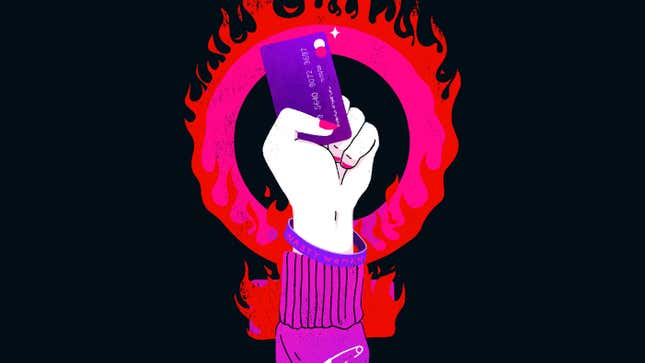The Business of Selling White Women the Righteousness of Their Own Anger
Latest
Illustration: Angelica Alzona/GMG
In her now-infamous speech at the Republican National Convention, Kimberly Guilfoyle, national chairwoman of the Trump Victory Finance Committee and famous girlfriend of Donald Trump Jr., shouted a string of semi-coherent nothings to an empty room: “Human sex drug traffickers should not be allowed to cross our border,” she raged. “Do you support the cancel culture, the cosmopolitan elites…who blame America first?… Or do you believe in American greatness? Believe in yourself, in President Trump… They want to destroy this country.” Her cadence was that of a cinematic despot by way of a Depression-era carnival barker, and Guilfoyle was absolutely selling a product—anger. But not just the same, passé, blue-collar, right-wing male version, the anger at old systems being dismantled in order to strip power from those who have come to believe they innately deserve power by right of birth. This was a newer, prettier rage, all wrapped up in lip gloss and hair extensions. This was Women’s Anger.
As a genuine human feeling, anger is often much closer to grief than any other emotion. Grief is part of the process by which a person acknowledges the loss of what was or should have been but is no more; anger is a pushback at the unfairness of the loss. A summer of protest over the mass loss of Black life at the hands of police officers and other authority figures across America throughout the course of this country’s history stemmed from a collective sense of mourning, rage, and, ultimately, hope that what is and has been foundationally wrong could one day be right. But in the four years since Donald Trump’s election, “Women’s Anger”—which, from a marketing standpoint, is almost exclusively white women’s anger—has become something other than an emotion anchored by grief and often gilded with hope. Instead, anger is the sole product, sold by both the left and right, as either a means of absolution or a tool to keep existing systems of power in place. In this model, white women are simultaneous manufacturers and target audiences, being moved down the purchase funnel in order to righteously buy back their own rage with no real purpose beyond having made the transaction.
In marketing speak, the “purchase funnel” has four stages: awareness, interest, desire, and finally action. The goal is to make consumers aware of a product by focusing on a problem and the utility of a product in relation to that problem, with the end game of keeping a brand in mind to foster a personal relationship that ends in not just a one-time transaction, but a lifetime of loyalty. From startups like The Wing to the “Nasty Woman” industrial complex, since 2016, Women’s Anger has been less about emotion and more about selling a product to white women in need of reassurance that they are on the right side of the vague problem that is America in general.
“That was what many women wanted: a remaking of the structure, of the systems and the institutions. And given what was happening on election nights in 2017 and 2018, it wasn’t such an outlandish request,” Rebecca Traister wrote in Good and Mad, a 2018 polemic on the potential of Women’s Anger to shape history. “Perhaps #MeToo wasn’t going to be about retribution; rather it might be about replacement.”
-

-

-

-

-

-

-

-

-

-

-

-

-

-

-

-

-

-

-

-

-

-

-

-

-

-

-

-

-

-

-

-

-

-

-

-

-

-

-

-








































